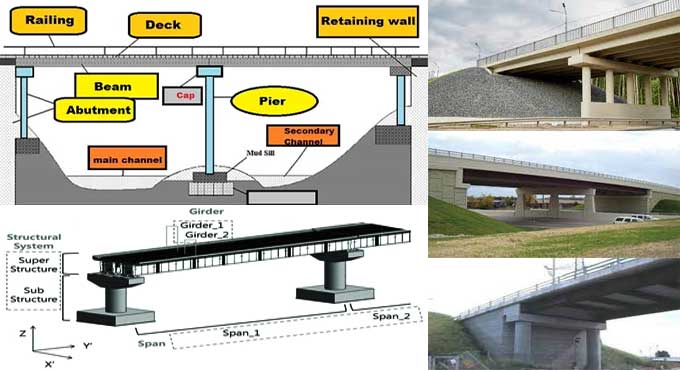NEWS | SOFTWARE | SHEET
Everything about Pier and Abutment in Bridge Construction
Providing vertical support for spans at intermediate points on the bridge structure as well as resisting horizontal forces acting on the structural elements, these piers fulfil two main functions: moving the vertical loads of the superstructure to the foundations and transferring the horizontal forces to the foundations.
It is becoming commonplace to design piers in order to be able to withstand high lateral loads as a result of seismic events even though they were designed originally to resist vertical loads.
The design of buildings is increasingly taking into consideration this aspect of ductility even in areas that have low seismic activity.
The majority of these piers are constructed from reinforced concrete, which is a very durable material. Steel tubes filled with concrete columns, to a lesser extent, are also used for piers. However, in recent years, Steel tubes filled with concrete columns have gained more and more attention.
Other factors about Piers
A conventional bridge consists of a pier or column that supports a bridge, such as a grade separation, a bridge over a stream, a bridge over a river, a bridge under a bridge, and a bridge over a culvert. There will be a detailed discussion of reinforced concrete columns, as well as a brief discussion of steel and composite columns.
In order to comply with the requirements of some of these special types of bridges, the substructures for the arch, suspension, segmental, cable-stayed, and movable bridges are excluded from the list of substructures.
Varieties of Piers
A pier may be classified into a number of different types depending upon the type of superstructure, the condition of the soil, and the manner in which it is constructed.
- Solid Piers
- Solid Reinforced Concrete Piers
- Open Piers
- Mass Concrete piers
- Prestressed concrete piers and reinforced concrete piers
- Fixed or permanent piers
- V-Shaped Concrete Pier
- Masonry Piers
- Pile Pier or Trestle Bent
- Cantilevered Piers or Hammerhead Piers
- Cylindrical Piers
What do you mean by Abutment?
An abutment is a substructure that is positioned at the ends of the span of a bridge or dam that supports its superstructure. Bridges with a single span have abutments at each end that act as both vertical and lateral supports for the span as well as retaining walls so as to prevent lateral movement of the earthen fill along the approach of the bridge.
Bridge abutments are substructures that support one end of the superstructure of a bridge, as well as lateral supports that serve to anchor the embankment which is used as an approach to the bridge.
It is also important to note that the abutment of a river bridge protects the embankment of the bridge from the scours of the stream. As a matter of fact, abutments for bridges can be constructed using concrete that is reinforced, plain concrete, or masonry.
What are the uses of Abutment?
- An object that resists or transfers self-weight, lateral loads such as those generated by the pressure of the earth and wind loads.
- A method of transferring loads from a superstructure to its foundations.
- The purpose of an arch bridge is to maintain the balance between the horizontal and vertical force components.
- An approach slab needs to be supported at one end in order to provide support.
Varieties of Abutment
There are mainly six varieties of the abutment which are listed as follows:
- Perched Abutment
- Stub Abutment
- Closed Abutment
- Spill-through or Pedestal Abutment
- Mechanically Stabilized Abutment
- Integral End Bents Abutment
To get more clear ideas, go through the following exclusive construction video tutorial.
Lecturer: Civil Engineers
Main differences between Pier and Abutment
| Detail | Pier | Abutment |
| Support | There are a variety of intermediate supports for a bridge's superstructure, referred to as piers that help it to support its superstructure. | Abutments are the end supports of the superstructure of a bridge, and they serve as the cornerstone of the structure. |
| Function | In general, piers have the function of transmitting the load from the bridge to the sub-soil beneath the bridge. | In order to transfer loads from the superstructure into the ground, the bridge has a system of abutments to support the ends of the bridge. |
| Material | It is important to note that a pier is essentially made up of two elements: a column shaft and the foundation. | The abutments can be constructed using brick masonry, stone masonry, mass concrete, precast concrete blocks or reinforced concrete construction (RCC). |
| Types | Solid Piers Solid Reinforced Concrete Piers Open Piers Mass Concrete piers Prestressed concrete piers and reinforced concrete piers Fixed or permanent piers V-Shaped Concrete Pier Masonry Piers Pile Pier or Trestle Bent Cantilevered Piers or Hammerhead Piers Cylindrical Piers |
Perched Abutment Stub Abutment Closed Abutment Spill-through or Pedestal Abutment Mechanically Stabilized Abutment Integral End Bents Abutment |
Recommended Articles:
Construction of bridge and its various components


